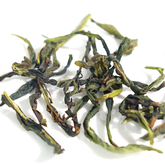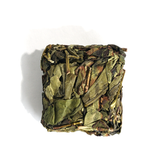The 6 Types of Chinese Tea in Chinese – With Pinyin and English Translation
Introduction When you see "Black Tea" on a menu, don’t rush to translate it as "Hei Cha" (黑茶)—it’s actually what we call "Hong Cha" (Red Tea) in Chinese! This historical misinterpretation dates back to the 17th-century European tea trade and still causes confusion among many Chinese learners and tea lovers today.
 Chinese tea culture has a long and profound history. Understanding the six types of Chinese tea not only helps you gain deeper insights into Chinese traditions but also improves your tea-related Chinese vocabulary and pronunciation. This article introduces the six major tea categories in Chinese, along with pinyin, English translation, representative teas, and flavor profiles—offering a real, clear, and practical guide to help you learn.
Chinese tea culture has a long and profound history. Understanding the six types of Chinese tea not only helps you gain deeper insights into Chinese traditions but also improves your tea-related Chinese vocabulary and pronunciation. This article introduces the six major tea categories in Chinese, along with pinyin, English translation, representative teas, and flavor profiles—offering a real, clear, and practical guide to help you learn.
What Are the 6 Types of Chinese Tea?
Chinese tea classification is mainly based on processing techniques and oxidation (fermentation) levels. According to official Chinese standards, tea is commonly divided into six main categories: green tea, black tea (called Hong Cha in Chinese), oolong tea, white tea, yellow tea, and dark tea (known as Hei Cha).
This method of categorization helps tea drinkers understand the flavor profiles, processing styles, and unique characteristics of each tea type.
| Chinese Name | Pinyin | English Name | Simple Description |
|---|---|---|---|
| 绿茶 | lü chá | Green Tea | Unfermented, light and fresh flavor |
| 红茶 | hóng chá | Black Tea | Fully fermented, rich and smooth |
| 乌龙茶 | wū lóng chá | Oolong Tea | Semi-fermented, floral and fruity |
| 白茶 | bái chá | White Tea | Slightly fermented, mild and mellow |
| 黄茶 | huáng chá | Yellow Tea | Light fermentation, smooth and soft |
| 黑茶 | hēi chá | Dark Tea | Post-fermented, aged and earthy |
Six Types of Chinese Tea – Side-by-Side Explanation
绿茶(Lǜ Chá / Green Tea)
Starbucks' “Matcha Latte” comes from Japanese powdered green tea, but Chinese green tea (like Longjing) is loose leaf tea brewed directly, preserving the full leaf.
Must-Try Classic: Biluochun (Bìluóchūn) – Named one of “China’s Top Ten Famous Teas” by The New York Times, it’s known for its intensely fruity aroma, once described as “so fragrant it startles.”
Pronunciation Tip: “Lǜ” sounds like “Lü” (as in German “ü”), simplified as “Loo” + a short “ee” sound.
白茶(Bái Chá / White Tea)
The “White Tea with Peach” you see in U.S. supermarkets is NOT authentic Chinese white tea! Real white tea (like Silver Needle) contains only tea buds—no added flavoring.
Fun Fact: Trader Joe’s bestselling Silver Needle White Tea is sourced from Zhenghe County (Zhèng Hé Xiàn) in Fujian, China.
Health Tip: A Harvard study found that white tea contains three times the antioxidants of blueberries (Food Chemistry, 2019).
黄茶(Huáng Chá / Yellow Tea)
Even rarer than green tea! Its unique “sealed yellowing” process produces a natural honey aroma, similar to sweet iced tea in the American South—but without sugar.
Buying Tip: You can find Junshan Yinzhen at Whole Foods—look for the label “Yellow Tea.”
Pronunciation Tip: “Huáng” is pronounced “Hwong,” like “Wong” but with a soft exhale at the start.
青茶(Qīng Chá / Oolong Tea)
The Tie Guan Yin at Teavana is the “light floral type,” but traditional charcoal-roasted oolong tea has a smoky flavor profile, reminiscent of American BBQ.
Fun Fact: Starbucks once released a “Golden Monkey Oolong,” which was actually a Fujian black tea, not oolong—so be cautious with naming!
Pronunciation Tip: “Qīng” sounds like “Ching,” similar to the start of “ching-chong” (note: avoid this phrase socially), spoken lightly and quickly.
红茶(Hóng Chá / Black Tea)
90% of Black Tea in the U.S. comes from India or Sri Lanka, but Chinese black tea (Hong Cha) like Lapsang Souchong has a smoky pine aroma that pairs beautifully with chocolate (like Godiva).
Historical Connection: The tea dumped in the Boston Tea Party was mostly Fujian black tea, historically known as “Bohea” (an old English word for Wuyi tea).
Pronunciation Tip: “Hóng” sounds like “Hong” in “Hong Kong,” with your tongue gently touching the gums behind your lower teeth.
黑茶(Hēi Chá / Dark Tea)
The fermentation behind popular Kombucha is similar to Chinese dark tea, but Hei Cha contains no sugar, and is made from actual tea leaves, not SCOBY.
Health Trend: Pu’er tea bags sold at Costco are recommended by Consumer Reports as a “belly fat blaster.”
Pronunciation Tip: “Hēi” sounds like “Hey,” but the tone drops sharply at the end—just like in American slang: “Hey, stop!”
About “CHA” and “TEA”
In the Chinese world, “Cha” (茶) and the Western concept of “Tea” are two fundamentally different things.
In the Western world, tea is often seen as an industrialized and standardized product. Due to the poor quality of raw materials used in mass-produced tea bags, the tea tastes unpleasant when brewed directly, making it hard to enjoy on its own. That’s why manufacturers often add artificial flavorings or additional ingredients such as fruit pieces, spices, or sweeteners to improve the taste. This is especially common in flavored blends like “Peach White Tea” or “Vanilla Chai Black Tea.”

In contrast, what Chinese people drink every day is a completely natural tea. It is handpicked and artisanally crafted without adding any artificial or non-tea ingredients. This aligns with the traditional Chinese philosophy of preserving tea's original character and flavor.

Chinese tea lovers highly value the pure taste of loose leaf tea, and are often strongly opposed to any form of artificial flavoring or additives. To them, tea is a living agricultural product, not a synthetic beverage.
This reflects two completely different product forms and processing methods: one prioritizes natural, whole leaf teawith unique terroir, while the other leans toward a convenient, flavored tea beverage tailored for mass consumption.
Summary
There are countless varieties of Chinese tea, and the six major types of Chinese tea are just a broad classification.
For example, when we talk about Black Tea (Hóng Chá), it refers to a large category. Within this type, there are many specific loose leaf black teas, such as Jin Jun Mei, Zhengshan Xiaozhong (Lapsang Souchong), and Dianhong Teafrom Yunnan.
In such cases, you’ll need to read the product label carefully to find the exact type and characteristics of the tea. Details like the region of origin, processing technique, and aroma notes will help you understand what you’re drinking.






